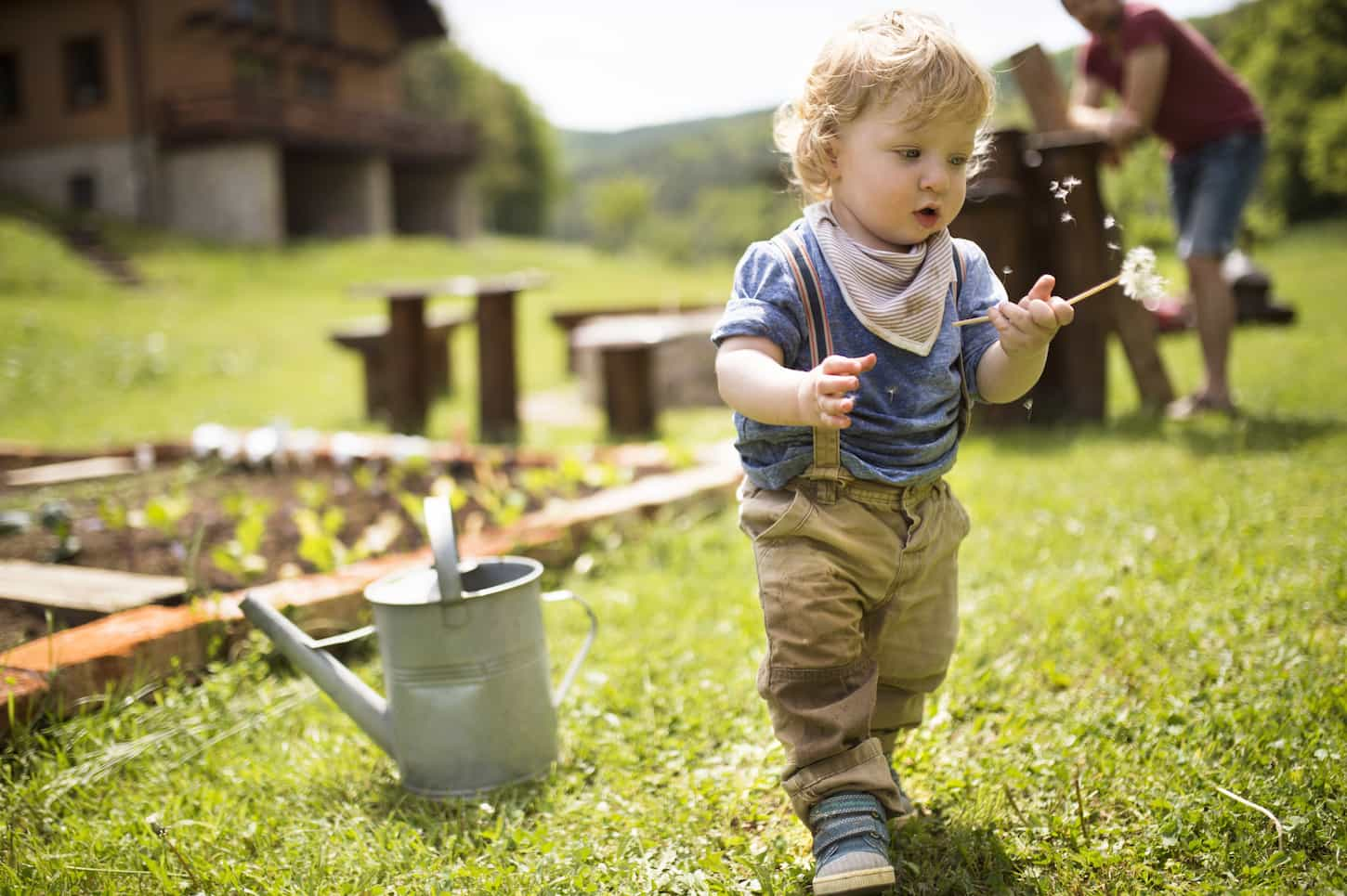Life with a toddler is confusing enough – and then suddenly they aren’t sleeping again? That’s what confused me the most when my toddler was 11 months old. I wondered if I would ever sleep again!
At 11 months old, toddlers can experience another temporary, transitional sleep regression. This is due to a combination of growth, developmental milestones, separation anxiety, and changes to sleep patterns that result in disrupted sleep patterns for the whole family.
Whether you’re in the middle of this sleep regression at 11 months or anticipating it, here are 30 things to know about the 11-month sleep regression.

Why Sleep Regression at 11 Months Happens
There are several reasons why your 11-month-old baby may experience sleep regression. Here are the most common culprits.
| Reason | Example |
|---|---|
| Change in routine | Changing the baby’s routine or sleep location can impact their ability to fall asleep and their sleep quality, triggering sleep regressions. |
| Physical development and milestones | At 11 months old, babies may be standing, walking, and/or cruising along furniture. Baby will need enough daytime practice to discourage practicing their new moves after bedtime. The nocturnal practice may still happen, though. |
| Nap transition (usually from two naps per day to one) | Sleep consolidation is amazing, but transitioning from two naps to one is a difficult process that takes time. During the transition, sleep regression is more likely to happen. |
| Developmental milestones | Social and emotional milestones can also trigger sleep regressions. Your 11-month-old baby loves interacting with people – and that can make bedtimes harder when they flash you that cute little smile. |
| Teething | Teething is painful – at least until the tooth erupts (pokes out). Once it’s out, the pain begins to subside and dull. This pain may be enough to wake your baby up at night – or at least lower the overall sleep quality and trigger a regression. |
| Illness | Colds and ear infections may be common at this age. Both may disrupt sleep quality and quantity during daytime and nighttime sleep. |
| Underlying medical condition | Reflux is a common medical condition that can disrupt sleep – and trigger all sorts of sleep regressions. |
| Separation anxiety | Your child has learned about object permanence – which means they know you’re there even when you’re in another room. So they’d like you to come back already, please. This can make bedtime and nighttime harder for a while. |
Why Your 11-Month-Old Wakes Up Crying During Sleep Regressions
Now, any of the reasons that cause separation anxiety (see above section) can cause them to wake up at night crying. However, the main reasons your baby wakes up crying at night are separation anxiety and exhaustion.
When anyone is exhausted, they’re far more likely to cry. Add in a limited vocabulary and crying is naturally the go-to method of communication. So your tired little almost-toddler is going to cry if (and when) they wake up in the middle of the night.
After all, they’re tired, confused, and they miss you. That separation anxiety is real – and they just want to be comforted already. So pick the method of comforting them that works for you – and let them know that you will always come when they need you.
Preventing the 11-Month-Old Sleep Regression
Is it possible to prevent the 11-month-old sleep regression? Maybe.
You might be able to prevent it. Practicing good sleep hygiene and using behavior-based sleep training methods may, in a best-case scenario, prevent this sleep regression.
You may not be able to prevent it. Even with all the preparation possible, you may not be able to completely prevent this sleep regression. In a worst-case scenario, however, doing all of this work will (at the very least) shorten the duration and severity of the sleep regression.

Do All Toddlers Experience the 11-Month Sleep Regression?
Not every child will have sleep regression at 11 months old, no. Some children may hit sleep regressions at 10 and 12 months – and skip this one. Other children will breeze right through this whole age with ease. But others will hit a snag in their sleep at 11 months of age.
There’s no way to determine how your baby will react until they reach 11 months old. Then they’ll make it quite clear whether or not there will be a sleep disruption at this age.
How Long Does Sleep Regression at 11 Months Last?
This sleep regression can last anywhere from a few days up to 2-6 weeks, depending on related (or causative) factors.
There’s a big range as some children naturally take longer (or shorter) amounts of time to recover and return to a reliable sleep pattern. And if new concerns pop up, it could continue (or even restart) the whole process.
One of my children had a series of unfortunate events that resulted in a months-long sleep regression. He had a developmental sleep regression followed by a cold followed by teething. Maybe the teething was before the cold – but you get the point. It was just the perfect storm of bad timing and sleep regressions.
However, if you’re just dealing with the sleep regression and you’re able to stay on top of things, it is quite possible to keep this sleep regression to only a few days.
When the 11-Month-Old Sleep Regression Will End
It can seem never-ending when you’re in the middle of this sleep regression, but it will end. And it will end within a matter of days or weeks, depending on you and your child’s reaction to it.
This is one of the first of the sleep regressions where your toddler can express more of their opinion – and where they can fight sleep. So if there isn’t some measure of control, then this sleep regression will take much longer to resolve.
It’s kind of the ugly transition between developmentally-triggered sleep regressions and ones triggered by anxiety and separation fears. And that’s okay. Just know that it will still end – within a few weeks, at the most – as long as you’re working on improving things with your family.
The #1 Most Important Tip to Managing Sleep Regressions is This…
Having a reliable, boring, and earlier-than-usual bedtime routine will be your top tip for managing sleep regressions. Why is that?
Well, going to bed a few minutes earlier can help your child get more sleep – and ease them back into a better routine where they sleep well.
For example: when our children first start displaying extra signs of crankiness, we move their bedtimes forward 15 minutes and focus on the bedtime routine (and cuddles!). For more cranky kids, we may move bedtime up as much as 30 minutes. After only a couple of nights, our children are sleeping better and we can go back to our normal routine.
Click here to read my article on why earlier bedtimes work – and why they’re the key to sleep regression management.

Signs and Symptoms of Sleep Regression at 11 Months
Here are the most common sleep regression symptoms for an 11-month-old:
- Increased crankiness during the day
- More periods of quiet playing than usual
- Frequent nighttime waking
- Fighting naps and/or bedtimes
- Change in appetite
- Inconsolable crying
- Night terrors
- Restless sleeping (during naps or at night)
- More tantrums than normal
- An increased desire to cuddle and sit still
- More spacing out when sitting still than normal
- More eye-rubbing or other symptoms of tiredness
- Dozing off after fighting a nap
My kids also requested far more cuddles, shows, and snuggles just before and during sleep regressions. Of course, this could also mean that they weren’t feeling well – but either way, it’s a good sign that they needed a slightly earlier bedtime that night!
What To Do to Manage the 11-Month-Old Sleep Regression
In order to survive any sleep regression, you need to have a plan. Here’s our basic survival plan for sleep regressions:
| Tip | Example | |
|---|---|---|
| Snuggles | Spend extra time during the day cuddling | Our kids were always exhausted during the day, so we spent extra time cuddling and reading together. |
| Outside Time | Get outside and wear everyone out! | Our kids did much better going to bed and taking naps when exhausted. We took trips to the zoo and parks to wear everyone out. |
| Nap Time | Do what works. | If naps suddenly require a car ride, plan a morning park trip with friends with a drive afterward. Or meet friends at a park that’s further away than normal. This is why we went to the zoo so often! |
| Rest Time | If naps don’t take, implement rest time. | My kids fought naps hard. So if one didn’t take, we’d watch a show and cuddle in a recliner. Often but not always, this triggered a short nap for both of us. And that’s okay! |
| During the Day | Do what you need to. | For us, dinner prep took a back seat to survival. Often this meant takeout or pulling a freezer meal out at the last minute. Do what you can to minimize stress for everyone. |
| Bedtime | Move bedtime up in 15-minute increments as needed. | As we got better at identifying sleep regressions, we could tell right off how much earlier to move bedtimes. But as you’re first starting out, move it up by 15 minutes and see how it goes. |
| During the Night | Do what you need to in order to maximize rest and sleep. | Survival mode at night is totally allowed! After all, you need enough sleep to function. So do what you need to and make that happen. You can focus on recovery and sleep training later. |
In case you’re wondering about feeding your baby during a sleep regression, the answer is yes! Just do it the same way you would during your normal sleep training routine. But don’t worry – I’ve got a whole article on feeding baby during sleep training for you right here. Check it out next.
Tips for Breaking Negative Sleep Associations at 11 Months Old
In some cases, the 11-month-old sleep regression may be triggered by negative sleep associations like nursing, pacifiers, or lost toys. It’s not as common, but it is possible.
You can read more about positive, negative, and external sleep associations right here.
If this is the case, it’s going to be harder to end the sleep regression until it’s been addressed.
I recommend using a concurrent, fading sleep training technique to break negative sleep associations for toddlers who are in the middle of sleep regression.
Breaking negative sleep associations for an exhausted child is even harder. For us, using a fading technique worked best for every negative sleep association except a pacifier (but we didn’t address that until our kids were at least 18 months old).
To read how to use fade it out, read my article on fading.

Creating Positive Sleep Environments for Toddlers
Having a positive sleep environment is especially key for toddlers. Most 11-month-old toddlers will still be in a crib. Even so, they will still sleep much better in a dark, quiet, boring, and comfortable room.
So make sure that their bedroom is a safe sleep environment.
We keep toys and books outside of bedrooms. We’ve found that having a separate place to play and read helps our children sleep better. It makes for a messier family room, but the better sleep has been worth it!
Click here to see what products and resources I recommend using in the ideal sleep environment for your child.
Your Routine is Your Key to Survival
Seriously – your routine is going to be what helps you stay sane and survive this sleep regression.
Even so, this sleep regression is hard because it does mess with your routine. So feel free to adjust things as needed. Use what works and ditch what doesn’t.
Be patient and know that your routine will settle into a new normal – eventually. Just be patient and persistent.
What Time an 11-Month Old Should Go to Bed (and how much sleep they need)
After extensive research and experimentation with our kids, here’s what we’ve found as far as what time an 11-month-old should go to bed – and how much sleep they should need.
| Age | Number of Naps | Average Length of Naps | Wake Time Between Naps | Bedtime | Nighttime Sleep Requirements | Sleep Required Each 24 Hours |
|---|---|---|---|---|---|---|
| 6-9 Months | 3 | 1-2 hours | 2-3 hours | 8-10 PM | 9-12 hours | 12-14 hours |
| 10-11 Months | 1-3 | 1-2 hours | 2-3 hours | 7:30-8:30 PM | 9-12 hours | 11-14 hours |
| 12-18 Months | 1-2 | 1-2 hours | 3 hours | 7-8 PM | 10-12 hours | 11-14 hours |
Keep in mind that these are just averages – but this particular age has a huge range because it’s a period of transition. In fact, this age is far less defined than the two ages on either end, which is why I included those for reference.
Adjust Bedtime (and Wake Up Time) as Needed
Knowing bedtime and total sleep requirement averages aren’t to give you a set schedule but are rather guidelines to help you find what works for your family. You’ll want to adjust bedtime (and wake-up times) as needed for your family.
For us, we found that our children’s naps during this age became a such poor quality that bedtime actually had to be moved as early as 6:30 PM some nights.
Eventually, our kids at this age were able to settle into a more reliable bedtime of between 6:30 PM and 7 PM – but our kids also take shorter-than-average naps. As such, our kids NEED an earlier bedtime.
Our kids naturally wake up between 6:30 and 7 AM each day, too. With some practice, we were able to get it closer to 7 AM each day to maximize their sleep – especially since naps were so unreliable and of poor quality.
So take the averages and use them as guidelines to work towards what works for your children – and your family.
Let Your Toddler Practice New Skills
At 11 months of age, your toddler may be toddling around – either with or without any help. This new skill can be hugely distracting at night – unless they’ve had plenty of daytime practice time.
So give your child time to practice during the day. In fact, give them LOTS of practice time during the day. This will help wear them out – and help them be much less distracted during the night. That way, they’ll actually sleep.
Re-Learn and Practice Sleeping Skills
At this age, your 11-month-old may need a remedial course on sleeping. If that’s the case, that’s okay! Dive back into sleep training and re-learn (or practice) good sleep hygiene.
In fact, sleep training isn’t going to be a one-time thing. You may have to use it several more times as they grow. That’s okay. Just make sure you’re picking an age-appropriate sleep training method and go for it.
Is it possible to sleep train bigger kids? Read my answer and article on how it is possible.
Your Toddler is Hungry – Feed Them!
At 11 months old, it seemed like each of my children’s appetites shot through the roof! They wanted more solid food but also more milk. So when your child is hungrier, go ahead and feed them.
For us, that meant an increased focus on food during the day – because I wanted to minimize night feeds.
My kids did experience some reverse cycling when I worked, even at this age. It was far less than when they were younger and totally dependent on nursing for their calories, but it still meant more night feedings. So I fed them – because they were hungry!
There’s still an awful lot of growing going on at this age. And they will calm down soon. So go ahead and feed those hungry, hungry kiddos.
Consider Nighttime Weaning
If you haven’t already, it’s okay to consider nighttime weaning at this age.
Of all four of our children, only our oldest boy was fully weaned at night by this age. And that was for two reasons:
- He wanted to wean; and
- Nighttime nursing had become a negative sleep association for him.
Fully night weaning him ended up being the best option for both him and us – and all of our sleep quality.
If it’s become an issue for your family, at least consider weaning. It may make all the difference for you, too.
Ask Your Village for Help When Needed
Asking for help during times of difficulty is totally fine. So guess what? A particularly difficult sleep regression (like this one at 11 months old) totally qualifies.
Ask friends and family for help. Then, let them help however they’re able and comfortable doing. In some cases, perhaps they’ll watch the kids for an hour so you can take a nap. Or maybe a dear friend will come and clean your kitchen for you while you try to nap with a cranky toddler.
Don’t be afraid to accept help. Raising children requires a village. So use your village’s help when offered.
Go to Bed Early (and take care of yourself!)
Going to bed early isn’t just a good idea for helping your baby get more sleep – it helps you, too. Okay, actually it helps any exhausted person.
But given how much you’ve been up with that baby each night, consider going to bed early – if only for a few nights. It’ll really help, trust me. And it will make a huge difference in your ability to parent and deal with things tomorrow – including surviving the sleep regression overall.
Watch Your 11-Month-Old for Sleep Cues
Sleep cues are a funny thing – they evolve as your child gets older. And this age is one of those times where your child’s sleep cues may be changing.
Here are what some of the typical, sleep cues look like:
- Increased impatience
- Increased cuddliness
- Rubbing eyes
- Staring off into space (disinterest)
- Increased irritability and decreased patience
- Tantrums
- Screaming
Of course, this exact order will vary from child to child. But figure out which cues are the early signs – and initiate sleep before you reach the late cues. That way, your child will get enough sleep.
My kids’ first sleep cue is increased cuddliness. If they get to eye rubbing, a full-out meltdown is imminent. So once my baby got cuddly, it was time for a nap – even if we had to skip steps to get sleep happening already.
Use Your Sleep Training Skills
Even if you aren’t actively sleep training your baby at this age, tap into those skills you learned. They’ll help you better manage this particularly difficult sleep regression.
The sleep training skills that best helped me survive these sleep disruptions were using a gradual, faded approach to reaching our sleep goal. And that way, I was able to be much more patient with my cranky baby.
Take 5 Minutes to Calm Down
Dealing with meltdowns and tantrums and sleep regressions is mentally and emotionally exhausting. So when you need to, take five minutes to calm down. Doing so will give you the stamina and ability to keep going – even when things are crazy difficult.
My favorite way to take five is to do some deep breathing or guided imagery meditation. Of course, eating some chocolate (or a taco lunch) in private also works from time to time.
Do what you need to in order to stay calm. It’ll help a ton.
Be Flexible During this Difficult Transition
This whole sleep regression’s theme is a transition. Things are changing – and that’s totally normal.
So go with the flow. Let your baby nap when and where they can if that’s what works. Just know that it will probably all change tomorrow – and so you’ll have to be flexible then, too.
Some days my kids napped in the car on the way home from the zoo. Some days, my 11-month-old would only nap in a hiking backpack worn around the house (or while mowing the lawn). Do what you need to – and be flexible.

Enjoy Outside Time
Getting sunshine and exercise is going to do wonders for both you and them. Not only will the exercise help them sleep better, but that sunshine will help them regulate their sleep-wake cycle better than anything.
So get outside – just be sure to dress appropriately for the weather.
Cranky Toddlers are Exhausted Toddlers
For reals.
Not-so-fun fact: cranky toddlers are tired toddlers. Some of them are even more than tired – they’re exhausted.
So if your toddler is cranky, know that they’re tired. Do what you can to help them get adequate sleep. If they won’t nap, move to bedtime earlier and help them get back to getting enough sleep that way.
Is There an 11-Month-Old Nap Regression that Impacts Sleep Regression?
Yes, there can be a nap transition that’s happening at 11 months of age. If your 11-month-old is transitioning from more naps to fewer naps, this will definitely impact their sleep quality – and may trigger sleep regressions.
After all, an exhausted baby is more likely to (paradoxically) wake up more at night.
So if your baby is in the middle of a nap transition, be flexible. Adjust bedtimes liberally (and as needed) to accommodate nap schedules – and help everyone get enough sleep.
Our kids did better with nap transitions at this age if we had A/B style schedules – on days they took more naps, bedtime could be at a more traditional 7 PM. On days they didn’t nap as much (or as well), bedtime became 6:30 PM or earlier.
Expect Naps to Be Difficult at 11 Months Old
Whether your baby is having a nap transition or not, expect naps to be difficult. And expect your baby to try and skip a few. It happens all the time!
In some cases, this will be a temporary power struggle. After a few weeks, most babies will settle back into their 2 nap routine.
So don’t feel like you need to immediately drop a nap – instead, use flexibility and an A/B style schedule to keep naps around longer. After all, most babies won’t drop that second nap until 14 or even 15 months of age.
Just know you may need to be extra flexible – some naps may be a glorified “rest time” of playing quietly in their crib. Some naps may be shorter than usual, too.
Be flexible but consistent – things will get better and stabilize in a few weeks.
Create a Daytime Schedule for Nighttime Sleep Success
At this age, you may want to entirely rethink your daytime schedule. Doing so may actually help your whole day go better.
At this age, I found that my kids did better all day when I moved their morning nap about 30 minutes earlier than usual. Moving the morning nap up helped me keep their afternoon nap at its usual, after lunchtime while also helping them be happier all day long.
At this age, morning naps will also naturally shorten in length. I’ve seen multiple sleep coaches who recommend capping the morning nap at an hour’s length. I disagree with that, though.
I’m of the opinion that sleepy babies sleep – so let them sleep. When they wake up, get them up and go have some active fun in the sunshine. Staying active during the day will help naps happen more naturally – and easier.
Tip: It’s tempting to want to keep the house quiet during the day – but don’t. Make daytime loud, fun, and full of laughter. Make daytime the fun time – so that nighttime is sleep time.
After more fun time and some lunch, have another nap or glorified rest time. Or if today’s a no-morning nap kind of day, move lunch and the after-lunch nap up by about 30 minutes.
Then, have a set bedtime – but allow it some flexibility to help get sleep back on track.
After a few weeks of this flexible schedule, things should settle into a better, more sustainable normal – and the sleep regression will be done.

Tips to Help Manage Separation Anxiety Caused Crying During Sleep Regression
Many children also experience nighttime separation anxiety at this age. So be sure to give your overtired child the extra emotional support they need – usually in the form of extra cuddles.
We found that adding extra cuddles to both nap and bedtime routines was a big help, as was spending daytime hours reading while snuggling.
And if doing all that extra cuddling isn’t helping enough? Here is one more tip to help manage that toddler separation anxiety in a safe, controlled environment.
- Tell your toddler that you need to go to another room for a minute (to get something or go to the bathroom).
- Leave the room for one minute – your baby may cry.
- Go back into the room and comfort your child.
Note: be sure to leave your child in a safe and/or monitored environment.
Doing this on a regular basis will provide some Pavlovian conditioning – it will teach your child that you do come back. Over time, you may be able to adjust the time spent away from your child up to a couple of minutes.
I still do this with my kids on a regular basis, even as they reach preschool age. It helps them use a controlled environment to manage separation anxiety.
It won’t be an immediate fix, but it does (over time) help immensely with separation anxiety. It teaches them that they can manage to be alone for a short amount of time – which will be a great help at night while they’re falling back asleep.
An anxious toddler may also have difficulty eating during the day (or night). This could lead to cluster feeding issues. If that’s the case for you, make sure you read this article I wrote on cluster feeding during sleep regressions next.
Yes, this sleep regression is awful. But hang in there – you’ve got this.